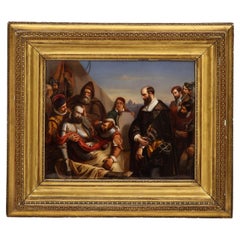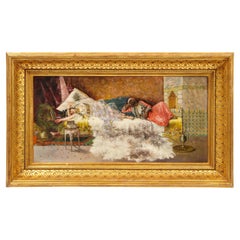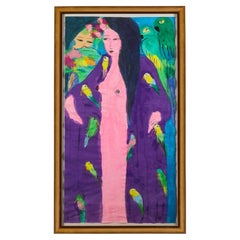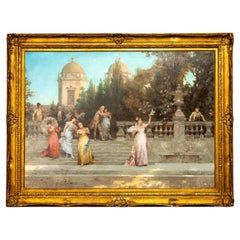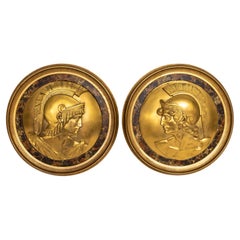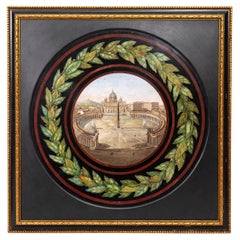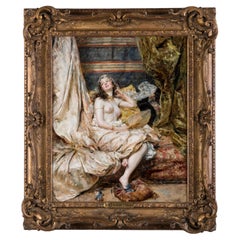Alexander's Antiques Wall Decorations
to
1
26
26
Height
to
Width
to
6
4
1
1
1
1
1
1
22
3
2
1
2
1
12
11
9
7
7
21
10
4
4
3
26
26
26
4
3
1
1
1
A Very Large and Unusual 19th Century KPM Porcelain Plaque by Carl Meinhelt
By Königliche Porzellan-Manufaktur (KPM)
Located in New York, NY
A Very Large and Unusual 19th Century KPM Porcelain Plaque by Carl Meinhelt. This plaque was produced by the Königliche Porzellan-Manufaktur (KPM) in Berlin and is signed by the art...
Category
Antique 19th Century German Medieval Paintings
Materials
Porcelain
$44,000 Sale Price
20% Off
19 C. Orientalist Oil on Canvas 'Prince and Princess in the Harem" Antonio Rivas
By Antonio Rivas
Located in New York, NY
An Incredible 19th Century Orientalist Oil on Canvas 'Prince and Princess in the Harem" signed by Antonio Rivas. Antonio Rivas (1845–1911) was a Spanish painter active in Rome, know...
Category
Antique 1890s Spanish Moorish Paintings
Materials
Canvas, Giltwood
A Walasse Ting Chinese Acrylics on Paper 'Two Geishas and Parrots' Painting
By Walasse Ting 1
Located in New York, NY
An Important and Large Walasse Ting Chinese Acrylics on Paper 'Two Geishas and Parrots' Painting. This painting is by Walasse Ting (1929–2010), a Chinese-American artist known for h...
Category
Vintage 1980s Chinese Modern Paintings
Materials
Acrylic, Paper
19th C. Italian Oil on Canvas Painting, 'Departure of the Guests', F. Beda
By Francesco Beda
Located in New York, NY
A Very Large and Quite Impressive 19th C. Italian Oil on Canvas Painting, 'Departure of the Guests', F. Beda. The oil painting Departure of the Guests, signed by Francesco Beda, capt...
Category
Antique 1870s Italian Rococo Paintings
Materials
Canvas, Giltwood
Pair of Grand Tour Gilt Bronze circular shaped plaques of Roman Gladiators
Located in New York, NY
A Fantastic Pair of 19th C. French Gilt Bronze Roman Solider Plaques of gladiators with Faux Marble Boarders. Each frame is beautifully hand-carved and the bronze medallions are in ...
Category
Antique 1890s French Louis XVI Decorative Art
Materials
Bronze
Large Antique Italian Micro Mosaic plaque of St. Peters Square, Rome mid 1800's
By Vatican Mosaic Studio
Located in New York, NY
A Very Large and Exceptionally Fine Quality Antique Italian Micro-Mosaic Plaque Depicting "The Saint Peter Square" in Rome. The center medallion surrounded by a beautiful Laurel Wreath in multiple shades of Green Mosaic amidst a black Belgium Marble border. The interior rounded subject depicts Saint Peter Square which is found in Rome, Italy. The entire center panel is made up of a captivating array of tesserae in a variety of shapes and colors, which create this stunning mosaic construct. When inspected from up-close, small rectangular tesserae are found in an assortment of colors, which include: white, green, blue, red, black, brown, orange etc. When the subject is seen from afar, a fantastic image of the entire Saint Peter Square can be viewed as if a painting has been created. The oil on canvas of this scene, by was sold in Christie's Auction for over $2,000,000 USD. The plaque rests in a custom ebonized and gilt square frame. This can be used as a decorative object on the wall to serve as a painting, or, be converted to a table-top by mounting it on a table stand.
Rome, Circa: 1850
Giovanni Paolo Panini (Piacenza 1691-1765 Rome), View of Saint Peter's Square, Rome.
From Christie's Auction:
Giovanni Paolo Panini arrived in Rome in 1711, painting capricci and architectural pieces in a vigorous if slightly eccentric style, and by 1719, when he was admitted to the Academy of St. Luke and the virtuosi al Pantheon, he was a rising star in the Roman art world. From around 1719-1726 he was much in demand for decorative frescoes, including quadratura, ornament and landscape and other genres, often in collaboration with figure or flower painters. During this period he worked for Cardinal Patrizi at Villa Patrizi, Cardinal Annibale Albani at Palazzo Albani (now del Drago) alle Quattro Fontane, Livio de Carolis at Palazzo de Carolis, Cardinal Alberoni at Palazzo Alberoni, Innocent XIII Conti in the Quirinal and in the library of S. Croce in Gerusalemme. In 1724 he married Caterina Gosset, the sister-in-law of Nicolas Vleughels, the director of the French Academy in Rome, to which he was admitted in 1732, and as a result he was much patronized by the French. During the 1720s he developed his figure style away from the awkwardness of his early works into one that concentrated on groups of stylishly-dressed aristocrats and skillfully modelled bystanders, sibyls and pseudo-antique figures. These he noted down in drawings (such as a sketchbook in the British Museum) that he drew upon to populate his paintings. He also began to receive commissions to design and record temporary festivals, often for French ambassadors to Rome.
By the beginning of the 1730s Panini was developing a distinctive subgenre of the capriccio in which recognizable monuments are placed in imaginary topographical relationships, which were well-received in the classicizing era of Clement XII Corsini. In 1732 he was one of the panel of judges for the competition instituted by Clement for the Lateran façade, and in the following year painted an impressive View of Piazza del Quirinale for the pope. At about this time he was developing his best-known topographical subjects, interior views of St Peter's and the Pantheon, which were much in demand, to judge by the number of extant versions extending into the 1750s. By about 1734 he was beginning to attract the attention of English patrons, who ordered sets of Roman views, such as those at Marble Hill House (1738) and Castle Howard. In 1736, through Filippo Juvarra, he received important commissions from Philip V of Spain for scenes of the life of Christ in the Chinoiserie room at La Granja in Spain (1736). From as early as the 1720s he had been producing some vedute (view-paintings), initially based on prototypes by Gaspar van Wittel, and he developed the genre in subsequent decades in works that would include impressive panoramic views of the Forum or Palatine, although his staple genre was the capriccio rather than the veduta. He also expanded his repertory of church interiors, adding such churches as S. Paolo fuori le Mura and S. Agnese in Piazza Navona, as well as church interiors recording special events. His son by his first marriage, Giuseppe (1718-1805), began to support him in architectural and festival design projects.
By the 1740s Panini was at the peak of his powers, and evidently had a considerable workshop helping him meet demand, especially of capricci to be used as overdoors and other decorative installations. Giovanni Paolo was successful in elevating himself socially above the usual artisanal status of genre painters, and would sometimes include a self-portrait in paintings commissioned by the great and powerful. He also appears to have been successful financially, and owned a substantial palazzo in via Monserrato. He increasingly concentrated on important commissions, such as a view of the Lottery in Piazza Montecitorio (London, National Gallery, 1743-1744), the designs for the festival decorations for the birth of the Dauphin in Palazzo Farnese (Waddesdon Manor, 1751), or the view of an imaginary picture gallery housing the collection of Cardinal Valenti Gonzaga (Wadsworth Atheneum, 1749). In the mid-1750s he received an important series of commissions from the Duc de Choiseul, French ambassador to Rome and soon to become one of the most powerful men in France, that included his best-known compositions, Ancient Rome (Roma Antica) and Modern Rome (Roma Moderna). These large paintings, of which there are three sets (in Boston and Stuttgart, the Metropolitan Museum, and the Louvre) represent imaginary picture galleries based on the Valenti Gonzaga composition but hung with what purport to be Panini's own vedute of ancient and modern sites respectively (with corresponding pieces of sculpture). These paintings sum up the eighteenth-century canon of the greatest works of architecture and sculpture, and the equivalence between modern and ancient Rome. By this time Panini was being assisted by his son by his second marriage, Francesco (1748-1800), who was a skilled draughtsman and painter who continued his father's work after his death in 1765.
The Farnborough Hall paintings
The Piazza S. Pietro and the Campidoglio are important vedute by Panini painted in 1750 and originally installed, with other works by Panini and Canaletto, in the seat of the Holbech family, Farnborough Hall, Warwickshire (National Trust). Farnborough Hall had been inherited in 1717 by William Holbech (circa 1699-1771), who is documented on the Grand Tour in Florence, Rome and Venice from late 1732 until his return home at the end of April 1734 with his brother Hugh. Holbech is said to have gone on the Grand Tour to recover from a broken heart and to have spent a considerable time there prior to these documented appearances. During his time in Rome he acquired two Paninis, which were seen by an anonymous antiquary around 1746, who referred to various sculptures "all brought from Rome with two pictures, one of the Rotunda, and the other of diverse buildings by Panino" (British Library, Add. MS 6230, pp. 31-32). The Rotunda (the Pantheon) is a painting now in a private collection in New York, and is signed and dated 1734. The Diverse Buildings, which was probably one of Panini's capricci, has not been identified. On his Grand Tour Holbech seems also to have acquired two Canalettos, although they are not mentioned by the antiquary, who may only have had eyes for things Roman.
In about 1746-1747, Holbech remodelled the house by creating a Saloon, now the dining room, at the back of the house. This room, the entrance hall, the staircase, library and closet were stuccoed by William Perritt of York, and a bill for this work dated 14 November 1750 survives (or survived until recently; G. Beard, Decorative Plasterwork in Great Britain, London, 1975, p. 233). The two Canalettos acquired on the Grand Tour were installed in the Saloon, together with two new works commissioned from Canaletto, who was then in England and working nearby at Warwick Castle in 1748. The two Paninis acquired on the Grand Tour may have been installed in the Library, as Alastair Laing assumes (op. cit.), while three new works commissioned from Panini in Rome were placed in the Hall and Saloon: the Piazza S. Pietro for the overmantel in the Hall (fig. 1), the Campidoglio as the overmantel in the Saloon (fig. 2), and an Interior of St Peter's (now in Detroit) (fig. 3) on the adjacent wall facing the windows. Two of the Canalettos flanked the Campidoglio, while the others were on the opposite wall. The Interior of St Peter's was therefore effectively the fifth member of the Canaletto set, distinct from the two overmantels.
Holbech's installation of his Canalettos and Paninis in fixed stucco frames was unusual for England in 1750, and had probably been inspired by what he had seen on his Grand Tour in Northern Italy, where fixed stucco installations of canvases were common in the 1720s and 1730s (Cornforth, II, p. 51). The Campidoglio and the Interior of St Peter's are both signed and dated 1750, a date that corresponds to the payments for the stucco.
The commission for the new Paninis would have been made through an agent, possibly the Roman dealer in antiquities Belisario Amidei from whom some of the antique busts in the Hall were acquired in 1745, who was also a picture dealer; or perhaps the painter Pietro Berton, who on 7 December 1750 shipped a Panini to England.
The paintings were sold to Savile Gallery in 1929 and replaced by copies by one Mohammed Ayoub. The four Canalettos were exhibited at Savile Gallery in 1930 and entered the London art trade, finding their way at various times to Augsburg, Melbourne, Ottawa and a private collection. The Paninis seem to have been resold immediately to Knoedler & Co. in New York. When the stucco was removed from the library by Holbech's great-grandson, another William Holbech, shortly after his succession in 1812, the Interior of the Pantheon and the Diverse Buildings may have been taken down. Although there is no record of either painting being at Farnborough subsequently, the Interior of the Pantheon at least must have remained there, since it appeared at Knoedler's in 1930 at about the same time as the other Paninis, and was presumably acquired at the same time from the same source.
The Campidoglio was a rare subject for Panini: this is the only known extant version, apart from fictive versions in the Metropolitan Museum (1757) (figs. 4) and Louvre (1759) versions of his Roma Moderna composition (but not in the first Boston version of 1757). Probably Holbech insisted on the choice of subject in order to represent the centre of Rome's civic administration to complement the religious one of St Peter's. The Campidoglio may have been of interest to English patrons because it represented the seat of a form of government they were more comfortable with than the papacy. For example, Canaletto painted the subject, together with English subjects, for Thomas Hollis, 'the most bigoted of all Republicans' in 1755, who may have wanted to 'represent London as the heir to the legacy of Ancient Rome and Renaissance Italy' (see Michael Liversidge and Jane Farrington, eds., Canaletto and England, exhibition catalogue, Birmingham Museums and Art Gallery, London, 1993, p. 25). Canaletto also painted the subject for Sir Richard Neave, Ist Baronet (1731-1814) of Dagnam Park, Essex, at the end of his English stay or shortly afterwards (i.e. 1755-1766) (sold, Sotheby's, London, 10 July 2002, lot 8). Like Holbech, Neave mixed Venetian and Roman subjects, but his Roman subjects steer clear of St Peter's: the others were the Piazza del Quirinale and Piazza Navona. While Holbech had gone to both Venice and Rome and commissioned views of both cities, Rome sets the keynote for his decoration: antique busts line the Hall, and its religious and civic centres are the overmantels in the Hall and Saloon respectively.
The Piazza S. Pietro
The Piazza S. Pietro shows the piazza much as it appears today, apart from the absence of Valadier's late eighteenth-century clocks on the towers. Bernini's colonnade (1656-1667), both ends of which are visible, reaches out its arms to embrace the viewer. In the center of the piazza is the obelisk moved by Sixtus V in 1586 from the left side of the church where it had formed part of the Circus of Nero. On either side are two fountains, the one on the right by Carlo Maderno (1613) and the one on the left created to match it by Carlo Fontana in 1677. Beyond is the rectangular forecourt to the church, the piazza retta, leading to the façade by Maderno, completed in 1610, and the dome by Michelangelo, Giacomo della Porta and Domenico Fontana. To the right of the façade the roof of the Sistine Chapel is just visible, followed by the Cortile di S. Damaso, the palace of the Swiss Guards and the palace of Paul V. A Cardinal is being driven in a carriage across the piazza at the right in the direction of the Borgo Nuovo and Ponte S. Angelo with his blue-liveried retinue and subsidiary carriages. Unlike the later versions of the subject that depict the Duke de Choiseul, there seems to be no intent to portray any particular cardinal: the procession of a cardinal here is presented simply as characteristic activity within the piazza. Various groups of figures, including well-dressed women in brightly colored dresses, Swiss Guards, priests, gentlemen, idlers and a pilgrim are distributed around the piazza. In the foreground an imaginary heap of fallen masonry provides visual interest in an otherwise dead space.
Panini painted the Piazza S. Pietro on a number of occasions, and his works falls into two types, one with the viewpoint shifted slightly to left of the axis, as in the Farnborough Hall version, and one with it shifted slightly to the right. The first type is based on a composition by Gaspar van Wittel, of which there are numerous versions from 1684 until 1721 (Fig. 9 van Wittel). The work by Panini that seems closest to Van Wittel and therefore probably the earliest is the version in the Circolo della Caccia, Rome, which has been dated to the second half of the 1730s, but is probably a decade or so earlier. Another, on the London art market in 2002-2009, and a version with workshop participation at Sotheby's, Milan (20 November 2007, lot 137) and currently on the art market in Rome, are closer to an important painting in Toledo (Arisi no. 308) that is signed and dated 1741 (fig. 6).
Van Wittel employed a wide format (about 2:1), showed both of the end faces of the colonnade almost to their full extent, and introduced the theme of a heap of masonry to enliven the foreground. His choice of perspective implies a viewpoint located in the small piazza between the Borgo Nuovo and Borgo Vecchio, now the Piazza Pio XII at the top of the Via della Conciliazione. From this viewpoint a building at the left tended to interfere with the view of the end of the left arm, as can be seen from the Nolli map...
Category
Antique 1850s Italian Louis XVI Decorative Art
Materials
Glass
19th C. KPM Porcelain Plaque (Painting), Gabriel Metsu’s ‘Lovers at Breakfast"
By Königliche Porzellan-Manufaktur (KPM)
Located in New York, NY
A Rare and Fine Quality Antique 19th Century KPM Painting on Porcelain Plaque after Gabriel Metsu’s ‘Lovers at Breakfast’ (Dated 1661), Metsu with his wife Isabella de Wolff in a Tav...
Category
Antique 1850s German Baroque Decorative Art
Materials
Porcelain, Giltwood
19th Century KPM Porcelain Plaque after Gerrit Dou, Titled "The Schoolmaster"
By Gerrit Dou
Located in New York, NY
An Incredible and Quite Rare 19th Century KPM Porcelain Plaque after Gerrit Dou (Student of Rembrandt, Titled "The Schoolmaster" c. 1671. The porcelain plaque is incredible with the...
Category
Antique 1850s German Baroque Paintings
Materials
Porcelain, Giltwood
A 19th C. Italian Oil on Canvas "The Cardinal's Present" by Arturo Ricci
By Arturo Ricci
Located in New York, NY
A Marvelous 19th Century Italian Oil on Canvas titled "The Cardinal's Present" by Arturo Ricci. This oil on canvas is truly incredible and one of Ricci's best works of art. The sce...
Category
Antique 1880s Italian Louis XVI Paintings
Materials
Canvas, Wood
A 19th C. KPM Plaque of Jan Hus at Constance Council, By Karl Friedrich Lessing
By Königliche Porzellan-Manufaktur (KPM)
Located in New York, NY
A 19th Century KPM Plaque of Jan Hus at Constance Council, Originally By Karl Friedrich Lessing, with the Original Giltwood Frame. The plaque is expertly framed in a meticulously cr...
Category
Antique 19th Century German Louis XVI Decorative Art
Materials
Porcelain, Giltwood
Dore Mounted King Louis XVI Terracotta Portrait Plaque, Jean-Baptiste Nini, 1780
Located in New York, NY
Dore Bronze Mounted King Louis XVI Terracotta Portrait Plaque by Jean-Baptiste Nini, 1780
This remarkable and historically significant antique terracotta portrait plaque bears the s...
Category
Antique 18th Century Louis XVI Wall-mounted Sculptures
Materials
Gold, Bronze
19th C. Meissen Porcelain Plaque of 'the Banishment of Ishmael and Hager'
By Meissen Porcelain, Adriaen van der Werff
Located in New York, NY
A 19th Century Meissen Porcelain Plaque of 'The Banishment of Ishmael and Hager', in its Original Frame. This fantastic Meissen porcelain plaque depicts...
Category
Antique 1870s German Baroque Paintings
Materials
Porcelain
19th C. Meissen Porcelain Plaque Depicting Rembrandt and Saskia in the Tavern
By Rembrandt van Rijn, Meissen Porcelain
Located in New York, NY
An incredible and very rare 19th Century Meissen porcelain plaque depicting Rembrandt and Saskia in the Tavern. Meissen plaques are incredibly rar...
Category
Antique 1860s German Baroque Porcelain
Materials
Porcelain
Silver-Ground Iridescent Green Horse Wall Panel, by Philip and Kelvin LaVerne
By Philip and Kelvin LaVerne
Located in New York, NY
A fantastic and quite rare acid etched metal panel of green iridescent horses on a silver ground, Signed Philip and Kelvin LaVerne. This is one of ...
Category
Vintage 1960s American American Craftsman Decorative Art
Materials
Metal
French 1st Empire Period Dore Bronze Grouping of Lovers, Att. Thomire A Paris
By Pierre-Philippe Thomire
Located in New York, NY
An Exceptional Antique French 1st Empire Period Dore Bronze Grouping of Lovers, Attributed to Pierre-Philippe Thomire a Paris. Exceptionally cast, hand-chiseled and further burnished and matted with two-tone gold, this dore bronze grouping of two neoclassical lovers is of the upmost quality and craftsmanship. As Pierre-Philippe Thomire is regarded as one of the greatest bronzier's of the late 18th century and early 19th century, this dore bronze piece could only be made by someone with his artistic talents. The lovers are seen with the man seated on a cushioned bench with tasseled...
Category
Antique Early 1800s French Empire Busts
Materials
Bronze
Meissen Plaque Depicting Four Royals Hunting in the Woods with a Dog and Rifles
By Meissen Porcelain
Located in New York, NY
An exceptionally fine and quite larege Meissen hand-painted porcelain plaque depicting four royals hunting in the woods with a hunting dog and rifles. This is the finest quality of a...
Category
Antique Mid-19th Century German Louis XVI Paintings
Materials
Porcelain, Wood
A KPM Hand-Painted Porcelain Plaque of a Japonism Beauty, Signed Wagner
By Wagner, KPM Porcelain
Located in New York, NY
A Gorgeous 19th Century KPM Hand-Painted Porcelain Plaque of a Japonism Beauty, Signed by the Artist Wagner Wien .n C. Kiesel. The beauty is seen in a beautiful orange and white kimono...
Category
Antique 19th Century German Japonisme Paintings
Materials
Porcelain
Exceptional French Oil on Canvas, "Feeding the Doves", Signed by E. Munier
By Emile Munier
Located in New York, NY
An exceptional French oil on canvas, "Feeding the Doves", Signed and Dated by E. Munier, 1890. Émile Munier is one of the most sought after and most talented French artists of the 18...
Category
Antique 1890s French Belle Époque Paintings
Materials
Canvas, Giltwood
Large Antique KPM Hand Painted Plaque of Young Beauty Symbolizing Victory
By Königliche Porzellan-Manufaktur (KPM)
Located in New York, NY
A large antique 19th century Belle Époque style KPM hand painted plaque of a young German woman wearing a bay laurel wreath, impressed KPM and scepter...
Category
Antique 1870s German Belle Époque Paintings
Materials
Porcelain
"A Village School" American Oil on Canvas, Kids in Class, Constant Mayer, 1871
Located in New York, NY
A beautiful American oil on canvas school room scene with a teacher instructing students who are seated on benches and on the ground, with one student who appears to be wearing a dun...
Category
Antique 1870s American American Classical Paintings
Materials
Canvas
Charles Stuart "Their Mountain Home" Oil on Canvas, Signed, 1895-1897
Located in New York, NY
Charles Stuart (British 1838-1907) "Their Mountain Home" from 1895-1897 is on oil on canvas and is signed as well as dated. This gorgeous highland landscape depicts a stag herd retreating down the mountain from the impending mists. Stuart captures the swirling movement and material quality of the fog, which obscures the towering mountains adding an element of mystery and magic to the painting. In juxtaposition, the foreground of the painting is rendered in precise detail from the rippling tides to the leaves of grass. Each stag is differentiated adding an element of naturalism.
Charles Stuart, F. S. A. was a landscape painter active from 1881 to 1904. Born to a long line of painters, Stuart exhibited at the Royal Society of British Artists and the Royal Academy. He was a fellow of the Society of Antiquaries of London, and the prestigious Savage Club whose members included Charles Dickens. He was married to Jane Maria Bowkett...
Category
Antique 19th Century English Paintings
Materials
Canvas
French Japonisme Hand-Painted Oil-on-canvas of a Geisha with a Fan
Located in New York, NY
A beautiful 19th century French japonisme oil-on-canvas painting of a Geisha holding a fan. This beautiful Geisha is modeled after the Japonisme movement brought up by French artists integrating Japanese artistic styles into their art work. During the mid-1870s, the demand for Japanese decorative arts...
Category
Antique 1880s French Japonisme Paintings
Materials
Canvas
Italian Orientalist Watercolor of "A Lady at the Bazaar", Umberto Cacciarelli
By Umberto Cacciarelli
Located in New York, NY
A Orientalist watercolor picture of "A lady at the Bazaar" from the 19th century is a cacophony of colors and textures. The lady demurely lowers her gaze while sensuously caressing t...
Category
Antique 19th Century Italian Islamic Paintings
Materials
Paper
Andy Warhol, Offset Lithograph with Collage of Colored Leather Samples, 1960
By Andy Warhol
Located in New York, NY
Andy Warhol (1928-1987).
1960, Untitled (Fleming-Joffe Colors).
Offset lithograph with collage of colored leather samples.
23 3/4 in. high x 17 7/8 ...
Category
Vintage 1960s American Art Deco Contemporary Art
Materials
Leather, Paper
Antique Painted Porcelain Plaque Depicting an Orientalist Beauty, Signed Vienna
By Royal Vienna Porcelain
Located in New York, NY
A very large and magnificent antique painted porcelain plaque depicting an orientalist beauty dressed in silk, jewelry, pearls, and 24-karat raised gold and enamel, signed Vienna. Th...
Category
Antique Early 19th Century Austrian Chinoiserie Paintings
Materials
Enamel
Monumental Pair of Porcelain Plaques of Orientalist or Turkish Women in Castle
By KPM Porcelain
Located in New York, NY
A pair of monumental and rare Antique German hand-painted polychrome enamel and raised gold porcelain plaques depicting orientalist/Turkish women standing in castles of exquisite cra...
Category
Antique Late 19th Century German Moorish Porcelain
Materials
Gold
Related Items
Chinese Export Watercolor Exotic Bird Paintings on Paper
Located in Downingtown, PA
China Trade watercolor paintings of exotic birds on branches are in watercolor and gouache on Chinese paper.
One picture depicts a pigeon perched on a tree branch with a landscape background. Chinese calligraphy can be seen in the top right corner. The second picture depicts two courting birds in shades of brown, both perched on a branch, also in a landscape background.
Both paintings framed with a green silk mat and contemporary gilt and dark wood frame.
Reference: Chinese Export...
Category
Antique Early 18th Century Chinese Chinese Export Paintings and Screens
Materials
Paper
Oil on Panel Painting 'Interior of the Harem' by Eduardo León Garrido
By Eduardo Leon Garrido
Located in London, GB
Executed in oil on panel, housed within a carved swept giltwood frame.
Signed bottom right 'E. L. Garrido,' and old stencilled stamps to the rear.
Dimensions (framed): H 79 cm by 68...
Category
Early 20th Century French Belle Époque Paintings
Materials
Paint
$51,460
H 24 in W 19.5 in D 4 in
Italian Orientalist Oil on Canvas Painting
Located in Cypress, CA
Italian orientalist oil on canvas painting.
20th century.
The fine oil painting depicting an orientalist woman dressed in traditional garments w...
Category
20th Century Italian Paintings
Materials
Canvas, Wood
Giovanni Antonio Raggi Orientalist Painting
Located in Savannah, GA
Giovanni Antonio Raggi
(Italian, late 19th century)
Scene depicting and hookah smoker.
Watercolor and gouache on paper.
sight: 14 by 20 ¾ inches
Frame: 23 by 30 inches
Category
Antique Late 19th Century Italian High Victorian Paintings
Materials
Giltwood, Paint, Paper
Parrots in the Jungle Haitian Acrylic on Canvas Painting
Located in Delray Beach, FL
Exceptional oil painting on canvas by Haitian artist depicts lush green jungle with bright and vivid colorful parrots overlooking beautiful lush jungle, acrylic paint on canvas, with...
Category
Vintage 1970s Haitian Decorative Art
Materials
Canvas, Acrylic, Wood
19th Century French Oil on Wood Orientalist Painting with Frame
Located in Marbella, ES
19th century French oil on wood orientalist painting with frame.
Dimensions with frame: 47 x 34 x 5.
Category
Antique Mid-19th Century French Paintings
Materials
Wood
Olympia Plaque Advertising Art Deco Chariot Gladiator
Located in Devon, England
A very attractive vintage Olympia wall plaque. There is a thin layer of copper that is embossed with the scene of a gladiator riding a chariot, very mu...
Category
Mid-20th Century European Art Deco Wall-mounted Sculptures
Materials
Copper
Superb Quality Antique Micro-Mosaic Grand Tour Souvenir of a Visit to Rome
Located in Montreal, QC
Superb quality antique micro-mosaic Grand Tour Souvenir of a visit to Rome. set with seven panels, vignettes of Roman views in a shaped slate tablet. and in original frame. Part of a...
Category
Antique 19th Century Italian Grand Tour Decorative Art
Materials
Marble, Slate
$4,500
H 4.75 in W 6.5 in D 1.25 in
Orientalist Painting of Harem Girl
Located in Queens, NY
Copy of Orientalist painting of a sleeping harem girl with vase of poppies & a white feather fan.
Category
Late 20th Century American Victorian Paintings
Materials
Paint
Antique Grand Tour Faux Book of Neoclassical Intaglios
Located in Wormelow, Herefordshire
An antique Grand Tour faux book of Neoclassical plaster intaglios.
Dating to the early 19th century, this intriguing book encloses twenty-five classically themed Italian medallions...
Category
Antique Early 19th Century Italian Grand Tour Decorative Art
Materials
Plaster
Large Antique Capodimonte Porcelain Plaque of a Naiad or Water Nymph
By Capodimonte
Located in Philadelphia, PA
A fine and large-scale Capodimonte porcelain plaque depicting a Naiad (or a water nymph from Greek mythology). She is attended by a small ...
Category
Antique Late 19th Century Italian Renaissance Porcelain
Materials
Porcelain
$2,400
H 18.5 in W 11.25 in D 2 in
Orientalist Painting of Harem Girls
Located in Queens, NY
Copy of Orientalist painting of two harem girls resting by a fountain in a courtyard.
Category
Late 20th Century American Victorian Paintings
Materials
Paint
